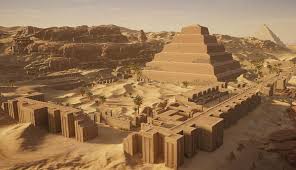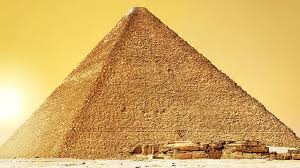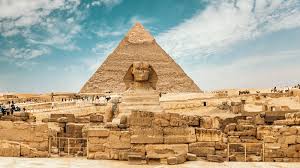0005. A Treatise on African Art: Lands of the Nile - Egypt, Nubia, and Ethiopia
- Afrilenstories
- Mar 29
- 4 min read
Updated: Jun 7
The Nile River, an ancient lifeline coursing through the heart of Africa, has shaped civilizations for millennia. From its origins in the highlands of East Africa, the river splits into two great tributaries—the White Nile and the Blue Nile—before converging and flowing inexorably northward.

Over centuries, this mighty river carved paths through deserts and fertile lands, sustaining societies that would leave an indelible mark on history. Its waters nurtured not just crops but cultures, fueling artistic and architectural marvels that still awe the modern world.
I. Ancient Egypt (Kemet)
The land that ancient Egyptians called Kemet, or the "Black Land," was named for the rich, dark silt the Nile deposited each year. This fertility was the foundation of Egyptian civilization, and over centuries, its people constructed a legacy of grandeur. Historians divide Kemet’s history into three great eras:
Old Kingdom (c. 2649–2134 BC) – A time of pyramid building and centralized power.
Middle Kingdom (c. 2040–1640 BC) – An era of artistic and literary refinement.
New Kingdom (c. 1550–1070 BC) – The height of Egyptian political and military expansion.
Each period of unity was followed by an Intermediate Period, marked by internal strife and external pressures. The Late Period (712–332 BC) brought waves of foreign domination, culminating in Greek conquest.
A. Old Kingdom - The Dawn of Monumental Architecture
In the vast desert, where shifting sands whisper secrets of ancient times, rose the first great stone monuments of human civilization. Among them, one structure stood apart—the Step Pyramid of Djoser at Saqqara. Built around 2620 BC for King Djoser (Netjerikhet), this towering masterpiece was not only an architectural marvel but also a declaration of divine authority.
The expertise gained from Saqqara paved the way for the most famous tombs of all:
The Great Pyramids of Giza:
Khufu’s Pyramid (c. 2551–2528 BC) – The largest and most ambitious of its kind.
Khafre’s Pyramid (c. 2520–2494 BC) – Standing slightly smaller, yet still imposing.
Menkaure’s Pyramid (c. 2490–2472 BC) – The last of the trio, though no less significant.
Each of these pyramids was not a solitary entity but a carefully designed complex, with temples, causeways, and smaller pyramids for queens and nobles. Together, they embodied the grandeur of a civilization that sought to etch its power into eternity.
B. Middle Kingdom - A Flourishing of Art
While the Old Kingdom expressed power through stone, the Middle Kingdom found its voice in art. Elite tombs became adorned with exquisitely detailed carvings, portraying scenes of daily life with remarkable realism. Human figures were rendered in both idealized and naturalistic styles, capturing the nuances of expression and movement. This was a time when art was not just about glorifying rulers but also about telling the stories of those who lived under their rule.
C. New Kingdom - Empire and Elegance
The New Kingdom saw Egypt reach the zenith of its influence, extending its grasp beyond its borders, from the depths of Nubia to the fringes of the Mediterranean and West Asia. This era brought military campaigns, grand temples, and luxurious tombs.

Nebamun’s Tomb Paintings – A glimpse into the life of a well-to-do scribe, these vibrant frescoes captured leisure, abundance, and religious devotion.
Tutankhamun’s Tomb – The 1922 discovery of the Boy King's burial chamber revealed a dazzling array of artifacts, each whispering secrets of opulence and sacred ritual.
II. Nubia and the Kingdom of Kush
A Land Between Worlds
Nubia, stretching from Aswan to the confluence of the White and Blue Nile, was both a neighbor and a rival to Egypt. Over three millennia, the two cultures exchanged trade, art, and at times, conquests. But Nubia was not merely a recipient of Egyptian influence; it developed its own unique traditions and innovations.
Kingdom of Kush - The Rise of the Nubian Kings
As Egypt’s power waned around 1000 BC, the Kingdom of Kush emerged as a force to be reckoned with. Its rulers, seated at Napata and later Meroë, saw themselves as rightful heirs to Egyptian tradition while infusing their culture with indigenous elements.

The Pyramids of Napata – Smaller but steeper than their Egyptian counterparts, these tombs were adorned with precious offerings of gold and rock crystal.
Temple of Amun at Gebel Barkal – A sacred site that reinforced the divine legitimacy of Kushite kings.
III. Kingdom of Aksum - A Powerhouse of Trade and Faith
As Rome and Persia vied for supremacy, another empire thrived in the Horn of Africa: Aksum. From the 1st century AD, it became a vital hub of trade, linking Africa with the Middle East and India.
Aksumite Coinage – Some of the earliest known coins minted in sub-Saharan Africa.
Cathedral of Mary of Zion – A church of profound spiritual significance, once believed to house the Ark of the Covenant.
IV. Early Christian and Islamic Art in the Region
A. Nubian Christianity
By the 6th century, Nubia embraced Christianity, fostering a culture of striking religious art. Churches, frescoes, and manuscripts flourished, particularly in Makuria, Nobatia, and Alwa.

Cathedral of Faras – Its stunning frescoes depict biblical figures blessing local bishops.
B. Ethiopian Christian Art
Ethiopia’s Solomonic Dynasty (13th–17th centuries) saw religious art reach new heights. Kings such as Zara Yaqob patronized illuminated manuscripts and church paintings.
Lalibela Rock-Hewn Churches – A feat of engineering and devotion, these structures were carved directly into volcanic rock.
C. Islamic Egypt
From the 7th century onward, Egypt transformed into a center of Islamic culture.

Mamluk Metalwork – Elaborate brass basins, often inscribed with Qur’anic verses and geometric patterns, symbolized the refinement of Islamic craftsmanship.
V. The Enduring Legacy
From the towering pyramids of Giza to the rock-hewn churches of Lalibela, the lands of the Nile continue to captivate scholars and travelers alike. The river that once shaped ancient empires remains, carrying with it echoes of those who came before, flowing steadfastly toward the horizon.
As we share this African art corpus, we express our deepest gratitude to great art historians, like Frank Willett, Peter Garlake, Dennis Duerden and Monica Visona; whose works have formed the foundation of this story. On other online sources we also relied.
Part of this writing was contributed by Denis Chiedo.














Comments